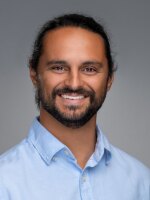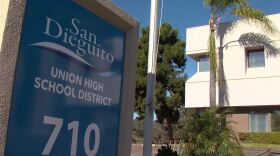San Diego County’s Otay Mesa Detention Center is among many immigration detention facilities nationwide beset by overcrowding – from detainees sleeping on the floor to deferred medical care resulting in hospitalizations, according to research and reports from immigration lawyers.
“A system that was very inconsistent to begin with is now complete chaos,” said Michael Garcia, San Diego County’s chief deputy public defender.
Garcia oversees the county’s immigrant defense program, through which more than 50 attorneys provide free legal representation to women and men detained at Otay Mesa.
“We’re definitely seeing it,” Garcia said of overcrowding conditions. “I get reports from my attorneys when they visit their clients all the time.”
According to a new report from Syracuse University, 84 of the country’s 181 immigration detention centers exceeded their contractual capacity in April, which is when the latest data was available.
The report shows the Otay Mesa Detention Center housed more than 100 people over its contractual capacity of 1,358 detainees.
The report notes that contractual capacity is different from physical capacity, and the two figures are not always the same. A detention center may exceed its contractual capacity while still having enough physical capacity for everyone detained there.
CoreCivic, the private company that runs Otay Mesa, did not respond to questions from KPBS.
ICE emailed the following statement:
“Any claim that there is overcrowding or subprime conditions is categorically false. All detainees are provided with proper meals, medical treatment, and have opportunities to communicate with their family members and lawyers. As we arrest and remove criminal illegal aliens and public safety threats from the U.S., ICE has worked diligently to obtain greater necessary detention space while avoiding overcrowding."
'Civil' prisons
With the administration pushing Immigration and Customs Enforcement (ICE) to meet arrest quotas of 3,000 people a day, detention centers are a key part of President Donald Trump’s mass deportation campaign.
Trump’s new budget bill allocates billions of new tax dollars for more detention space.
Have a tip? 📨
The Investigations Team at KPBS holds powerful people and institutions accountable. But we can’t do it alone — we depend on tips from the public to point us in the right direction. There are two ways to contact the I-Team.
For general tips, you can send an email to investigations@kpbs.org.
If you need more security, you can send anonymous tips or share documents via our secure Signal account at 619-594-8177.
To learn more about how we use Signal and other privacy protections, click here.
From the outside, the Otay Mesa Detention Center looks like a prison. It’s surrounded by tall barbed wire fences, guards and security cameras monitor every visitor. Windowless walls prevent anyone from the outside from seeing inside.
But the facility is not technically a prison or a jail. Immigration detention is classified as civil detention because people are not being held because of a specific criminal offense. It’s meant to house people waiting to be deported or for their hearing before an immigration judge. Not people facing criminal trials.
“They call it civil detention as a way to differentiate it from incarceration,” said Tracy Crowley, a lawyer with the Immigrant Defenders Legal Center. “But I worked as a criminal defense attorney for years. It’s no different.”
Guards often refuse to call detainees by their names. Instead, they use the last four digits of someone’s case number, according to Sydney Johnson, an associate attorney with Jacobs and Schlesinger.
Johnson has also heard guards refer to detainees as, “body.” For example, “Do you have the body? Or are you transferring the body to legal?”
“It just takes away from their humanity,” Johnson said. “It’s hard to listen to.”
Poor living conditions
One common complaint lawyers are hearing is detainees being forced to sleep in overcrowded rooms.
“There’s around 10 or 13 people inside one room, and there’s only eight beds in each room,” said Valerie Sigamani, a San Diego-based attorney.
Those who do not get a bed sleep on a mat on the floor, she added.
“From what I’ve heard, because they’re sleeping on the floor, the males have been getting a lot more sick because they have the air [conditioner] hitting them from below,” Sigamani said.
Multiple lawyers told KPBS that their clients have become sick in the detention center. Some because of neglected medical care and others because of unsanitary conditions.
Crowley said a client of hers developed a rash she believes came from dirty clothes and bedsheets.
“He had a rash all over his body, made it so he couldn’t sleep,” she said. “Every time we were meeting to discuss his case, he had to itch his body.”
Her client repeatedly asked for an anti-itch cream so he could sleep at night. But staff would only bring a little cup, she said.
Johnson said two of her clients detained at Otay Mesa have been hospitalized. She said a combination of factors, including poor nutrition and delayed medical care, exacerbated their medical conditions.
“Things keep happening over and over again and not really be fixed, instead it’s just sort of waiting until it hits a breaking point and you have to transfer them to an emergency room,” she said.
Poor communication
Immigration lawyers told KPBS that they struggle to reach anyone in the detention center – whether it is to advocate for their clients or inquire about upcoming court cases.
Johnson said two of her clients were transferred to other detention centers, including one in Louisiana, without her knowing.
“It’s incredibly frustrating because there’s not really one person you can be in contact with,” she said. “A lot of the time, you contact USCIS (U.S. Citizenship and Immigration Services) and they say contact ICE. You contact ICE and they say contact USCIS.”
Garcia, who runs the county’s immigrant defense program, said confusion is the primary problem. Almost like the system is not built to process so many cases so quickly.
“It’s so overcrowded that there’s confusion up and down the system,” he said. “Somebody will be told that they’re going to have their credible fear interview on an asylum case, and it never happens,” he said.
Lawyers told KPBS that agents inside the detention center pressure detainees to sign “voluntary departure” papers, which is essentially a form of self-deportation.
“A lot of the clients are just choosing to not fight their case anymore,” Garcia said. “Which is probably by design and exactly what the administration wants.”
All the lawyers KPBS spoke to said they feel guilty whenever they leave Otay Mesa.
“It feels really bad, in a way, to leave knowing that my clients can’t leave,” Crowley said.
Johnson said sometimes it feels like “cruelty is the point.” That the administration wants both immigrants and their lawyers to burn out.
“To encourage people to just give up and go home, and maybe even to encourage attorneys that maybe this isn’t something you can do for a lone time because it’s heartbreaking,” she said.
Sigamani says it’s difficult not to take the work home.
“We probably cry a few times,” she said. “Understanding that good people are sitting in here and being mistreated and feeling like there’s nothing we can do about it.”
But, she said, there is something they can do about it. They can keep showing up. And keep serving their clients.






